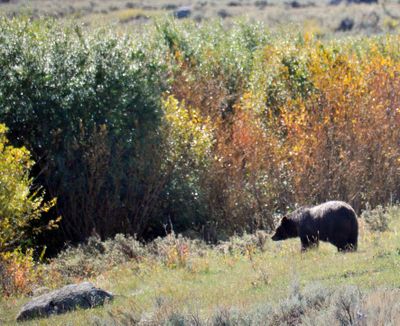Federal government restarts effort to restore grizzly bears to Washington’s rugged North Cascades

A stop-and-go federal process to restore grizzly bears to Washington’s rugged North Cascades began anew Thursday. However, unlike in previous efforts, the federal government is considering a separate designation that would provide more flexibility when managing individual bears.
“It’s certainly encouraging,” said Joe Scott, the international program director for Conservation Northwest. Scott has spent nearly 30 years trying to return grizzlies to Washington.
The National Park Service and the U.S. Fish and Wildlife Service announced the start of a new Environmental Impact Statement process to “evaluate options for restoring and managing grizzly bears” Thursday. The first of four public meetings is Tuesday .
“It’s a great first step toward figuring out how to chart a path to restoring grizzly bears to their rightful habitat,” Scott said.
The proposal has been criticized by some who worry the apex predator will kill livestock and endanger humans.
“The introduction of grizzly bears into the North Cascades would directly, and negatively, impact the people and the communities I represent,” 4th District U.S. Rep. Dan Newhouse said in a statement. “My constituents and I have consistently opposed proposals to do so under multiple administrations because introducing an apex predator to the area would threaten the families, wildlife, and livestock of North Central Washington. It is disappointing that local voices are once again being ignored by federal bureaucrats, even after the last process was discontinued due to overwhelming local opposition.”
Newhouse encouraged Washingtonians to attend the scheduled public meetings.
In a previous effort, which started in 2014 and was halted by the Department of the Interior in 2020, the agencies collected more than 140,000 comments. They also published a draft environmental impact statement. That statement offered three alternatives to restore a population of about 200 bears, all based on a plan to relocate animals to 9,800 square miles of mostly public land in and around North Cascades National Park.
That work, and those comments, aren’t lost, said Jason Ransom, the North Cascades National Park wildlife program lead.
“We will start from where we left off and edit from there,” he said.
Since 2020, the Park Service has continued to study reintroduction and has found that it remains feasible.
For instance, one study looking at various climate change models found that grizzly-friendly habitat in the North Cascades will likely increase as shrubs – such as huckleberries – extend their range into higher elevations, Ransom said. That study is going through the final stages of peer review. The Park Service was given the final go-ahead from the Department of Interior to start the public process Tuesday, Ransom said.
Unlike with previous efforts, the agencies will consider experimental population designations, which allow “a lot more flexibility” when it comes to managing animals listed under the Endangered Species Act and could alleviate concerns about giving local control to the federal government, Ransom said.
Despite being half a day’s drive from Seattle, the North Cascades feature some of the most rugged – and remote – terrain in the Lower 48. Historically, it was prime grizzly bear habitat, with a 2018 Park Service historical analysis finding 178 credible observations of grizzlies between 1859 and 2015. The report looked at fur trading records and in-person sightings. It also examined older accounts and archaeological evidence from Native American cultures in Washington.
The last confirmed sighting of a grizzly bear in the U.S. portion of the North Cascades was in 1996.
The North Cascades Ecosystem, stretching from Interstate 90 north to the Canadian border, is one of five Grizzly Bear Recovery Zones in the U.S.
If a reintroduction occurred, the USFWS would have primary management responsibility of the animals. The Washington Department of Fish and Wildlife would provide scientific monitoring and outreach to local communities and recreationists, according to a WDFW statement.
“We are committed to grizzly bear recovery in Washington and plan to partner with the federal agencies and provide technical support to their initiative,” Eric Gardner, WDFW Wildlife Program Director, said in a statement.